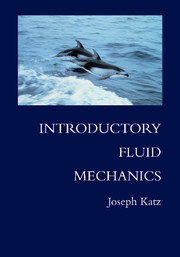Book contents
- Frontmatter
- Contents
- Preface
- A Word to the Instructor
- 1 Basic Concepts and Fluid Properties
- 2 The Fluid Dynamic Equation
- 3 Fluid Statics
- 4 Introduction to Fluid in Motion – One-Dimensional (Frictionless) Flow
- 5 Viscous Incompressible Flow: Exact Solutions
- 6 Dimensional Analysis and High-Reynolds-Number Flows
- 7 The (Laminar) Boundary Layer
- 8 High-Reynolds-Number Flow over Bodies (Incompressible)
- 9 Introduction to Computational Fluid Dynamics
- 10 Elements of Inviscid Compressible Flow
- 11 Fluid Machinery
- Appendix A Conversion Factors
- Appendix B Properties of Compressible Isentropic Flow
- Appendix C Properties of Normal Shock Flow
- Index
1 - Basic Concepts and Fluid Properties
Published online by Cambridge University Press: 05 June 2012
- Frontmatter
- Contents
- Preface
- A Word to the Instructor
- 1 Basic Concepts and Fluid Properties
- 2 The Fluid Dynamic Equation
- 3 Fluid Statics
- 4 Introduction to Fluid in Motion – One-Dimensional (Frictionless) Flow
- 5 Viscous Incompressible Flow: Exact Solutions
- 6 Dimensional Analysis and High-Reynolds-Number Flows
- 7 The (Laminar) Boundary Layer
- 8 High-Reynolds-Number Flow over Bodies (Incompressible)
- 9 Introduction to Computational Fluid Dynamics
- 10 Elements of Inviscid Compressible Flow
- 11 Fluid Machinery
- Appendix A Conversion Factors
- Appendix B Properties of Compressible Isentropic Flow
- Appendix C Properties of Normal Shock Flow
- Index
Summary
Introduction
The science of fluid mechanics has matured over the last 200 years, but even today we do not have complete and exact solutions to all possible engineering problems. Although the governing equations (called the Navier–Stokes equations) were established by the mid-1800s, solutions did not follow immediately. The main reason is that it is close to impossible to analytically solve these nonlinear partial differential equations for an arbitrary case. Consequently, the science of fluid mechanics has focused on simplifying this complex mathematical model and on providing partial solutions for more restricted conditions. Therefore the different chapters on classical fluid mechanics are based on retaining different portions of the general equation while neglecting other lower-order terms. This approach allows the solution of the simplified equation, yet preserves the dominant physical effects (relevant to that particular flow regime). Finally, with the enormous development of computational power in the 21st century, numerical solutions of the fluid mechanic equations have become a reality. However, in spite of these advances, elements of modeling are still used in these solutions, and the understanding of the “classical” but limited models is essential for successfully using these modern tools.
This first chapter provides a short introduction on the historical evolution of fluid mechanics and a brief survey of fluid properties. After this introduction, the fluid dynamic equations are developed in the next chapter.
- Type
- Chapter
- Information
- Introductory Fluid Mechanics , pp. 1 - 31Publisher: Cambridge University PressPrint publication year: 2010



